Part 1: First steps and emancipation
Zero Hour
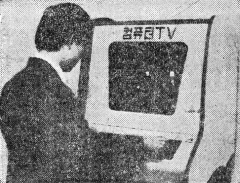
The first Korean arcade machine? Computer TV in 1976
|
The history of video games in the Republic of Korea begins in 1975. While the odd arcade machine—maybe imported for American GIs, maybe by some illegal underground slot machine room—might have hit Korean shores before, this is the time when a broader public first became aware of the medium. In January that year, three units of the relabeled Pong machine Computer TV were installed in the Midopa Department Store in Seoul1. The newspaper Maeil Gyeongjae ("Daily Economy") innocently explained "It is called TV game, and from the outside it just looks like a TV set." According to the article, a lot of big companies were producing machines and preparing them for export, like Samsung, Goldstar and many less known companies2, some long forgotten, as is the answer to the question of what became of most of these products.
Various Pong clones were sold here and there, most of them in tiny runs, but the only Korean video game machine of 1976 that left an impact came from a company called Olympus, who were until then known as manufacturer of digital wristwatches. Later that year, they shipped the Pong console that would greet the world as Gamatic 7600 to several countries around the world, including West Germany, Denmark, Sweden, Ireland, Canada and Chile3. In Korea, the machine that supported 4 different play modes wasn't released until the beginning of the next year, there to be known as Otron TV Sports, in tune with their Otron series of wristwatches. A later Model 7800 came with a lightgun and 2 additional games suited for the new peripheral4.
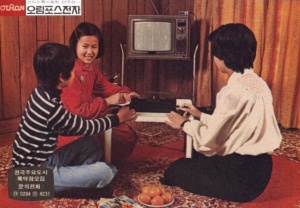
Advertisement for the Otron
|
Olympus fostered plans to continue the line with a console that supports exchangeable cartridges in 1981 and seems to have even entered production, but the company was in financial trouble at the time and accounts of the console are nowhere to be seen, so it remains uncertain whether it was ever sold5. Next came the Magicom by Taegwang Electronics, also in typical 70s console design with paddle holders and curly phone cords. The manufacurer even claimed it used a 16-bit microprocessor6, which could mean it was based on the Mattel IntelliVision, although the shell looked different from all known IntelliVision variants. This console can at least be confirmed to have existed in 1983. It appears, however, that the Korean market wasn't yet ready for such a device, as no trace seems to be left of it, either.
Some businesses imported video game consoles like the Atari VCS and Colecovision to Korea, but that was all the more stuff only insiders knew about. Goldstar (now LG) announced in 1984 that they would invest 200 million Won in the development of a game console until the end of the following year7, although the claim was never followed up on in any further news. Daewoo even seems to have produced a pair of game consoles in 1984, the DPC-80 and DPC-90, respectively. These two were offered at least until 1987, but literally nothing is knowable about them other than their model numbers, despite them being described as "well received" in late 19858.
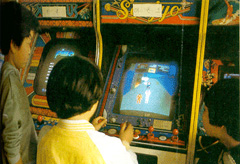
An 80s arcade. The machines have titles in Hangeul taped onto the marquee.
|
When exactly video game arcades entered Korea cannot be traced accurately, as they typically evolved out of slot machine or pinball rooms, and the first accounts are in fact news about crackdowns on the aforementioned illegal establishments. In december 1976, the US embassy offered "Tele Tennis" machines for a price range of $590 to $13509. Until the end of the 70s, "electronic entertainment rooms" (jeonja oraksil) quickly spread around the country, despite fierce opposition by conservative parents and media in a still somewhat confucian society10. Under the long headline "Addiction... the 'electronic toadstool' growing from the students' pockets—hotbed for the derailment of youth ... the reality of unauthorized electronic entertainment rooms", the Dong-A Ilbo wrote in 1980:
"Pew pew! Bang Bang!" It's not a battlefield, but it is a site made to resemble a battlefield. An electronic entertainment room, the deformed child of the highly developed electronics industry.
These rooms seduce mostly elementary, middle and high school students. They have it in for their thin wallets, want the money meant for their school supplies, books and even their school fees, have started to grow in numbers rapidly, and have been shown to pose many problems to the guidance of children.
The games are so addictive that once entered, the children can't bear to come out again before they spent all the money in their pockets; the content of the game is mostly the reenactment of war, and the instructions also use pure martial slang, and there are not few worries that they hinder a healthy formation of character. (...)
When electronic entertainment machines were first introduced, most were sports entertainment like soccer, tennis and car racing, but every day new machines matched to the students' tastes are introduced continuously, and now the majority are war games with foreign titles like "Space Invader," "Space Chase," "Super Sports," or "Scramble".11
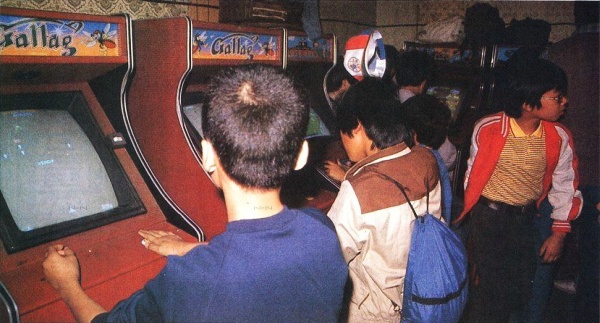
Playing Gallag, a Galaga bootleg (photo: The Kyunghyang Shinmun 10/20/1983)
|
Neither did the totalitarian regime of the time didn't like the new institutions, no doubt the major cause for a rising youth criminality. By 1980, only 43 arcade establishments were government-approved, while many hundreds were opened illegally12. In march the police enacted a relentless crackdown on those businesses, closing down 361 of 858 known arcades and confiscating all the machines (402 had closed shop voluntarily, following the government's ultimatum)13. Even that couldn't hope to gain a lasting effect, though, as soon after the shady industry flourished again. Two years later estimates were up to 3,500 illegal arcades in Seoul only14, 20,000 in 198315. But numbers were always sketchy, as the machines were often hidden away in the back of counterfeit bookstores16. A first small breakthrough in the eyes of the public, however, came in September 1983, when a new law enforced a distinction between establishments for gambling machines and those for actual video games17, so games couldn't be blamed anymore for drawing kids to the more vicious pastimes of adult entertainment, at least.
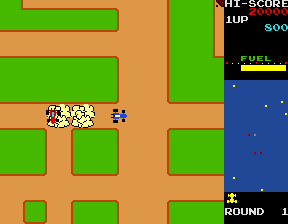
The "Fart Car"
|
Just like about every country that isn't the US or Japan, the games industry in Korea started as mostly an import market. Machines, often bootlegs, came mostly from Japan, but also the USA in their original cabinets, without any form of localization. However, the kids needed names to call the games, so clever arcade manufacturers would tape names in Hangeul, the Korean writing script, onto the marquees. During that progress, they weren't always completely accurate and at times got inventive. For that reason, Street Fighter was called Jang Pung (Palm Wind) after the Korean name for the Hadouken, Donkey Kong had to become the more famous King Kong, and Bubble Bobble is still better remembered as Boggle Boggle (playing on an onomatopoetic expression that originally depicts the bubbles that rise from cooking water). The hardest lot received Namco's Rally-X, which was known as "Fart Car" (방구차, Banggucha)18, a choice that becomes immediately understandable even by looking at screenshots of the game. A later mobile phone port by Eolith even wears that title officially. Due to the unofficial nature of these titles, there used to be variations from location to location with some games. This even applied to domestic arcade games later, which in heavy contrast to the contemporary home entertainment software were comparatively strong on the export market in their early years, and thus labeled in English by default.
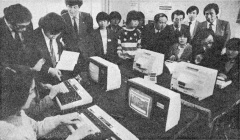
Korea's first computer study room in 1983
|
Home computers started being available Korea in the late 1970s, although at first as a rare luxury import. Software programming thus remained the domain of institutes like KIST (Gwahak Gisul Yeonguso, later KAIST), where "software for design and various games" were created on an unnamed computer system in 197919. A somewhat whidespread circulation wasn't guaranteed until 1983, when the emergance of several domestically produced home computers—often clones of Japanese and American models20—and computer magazines attest a mainstream interest in the new technology. Many companies sold their own manufactured computers with Z80 or 6502 processors, and provided games in form of tapes and source codes in magazines for their various models. Some magazines also started to print their "own" games, and later also code submitted by homebrew programmers. Those were for the most part very small programs with no more than a few pages of source code, and given their simplicity and age it is quite impossible to determine which of them were original developments and which were mere conversions of foreign source code.
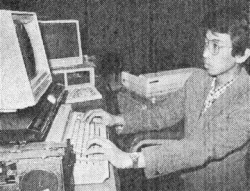
Hwang Geonsun in front of his computer
|
The biggest impact, however, came from the installation of computer study rooms in schools throughout the country. Starting with the Seoul Dongdeok Girls' High School in March 198321, companies like Samsung offered the hardware to advance the raising of a computer-savvy generation. It was the public schools where the first teenagers learned to program. The young Ha Hyeongjin, who won the first prize at Samsung's Personal Computer Software Competition in Fall 1983, was no exception: The computers at his school in Daegu Gyeseong had just been installed in June22. His game, Neoguri, seems lost to the ages; apparently it was a clone of the Korean favorite Ponpoko, although the description (climb up the stories to get the bride at the top) hints at a Donkey Kong influence, too. Despite having programmed more than 20 games, Ha Hyeongjin claimed he'd never been in an arcade, and his dream wasn't to become a game designer, but an atom physicist23.
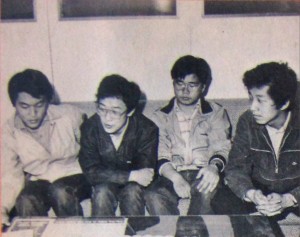
The Hayarobi Soft team
|
Competitions were in general the source that produced the most software in these days. Samsung used to host them regularly and publish the results on compilation tapes afterwards. Another impressive entry came from one Hwang Geonsun. His SPC-1000 port of the Japanese PC-88 game Lunar City SOS earned him the runner-up prize at the 3rd Software Competition in 1984 (the first prize went to an office application this time). His only comment: "I thought it would make first prize. It's a really good program."24. Later his father quit his job and founded the company Static Soft to foster his son's talent25, but soon the prodigy would just resort to the simple converting of Japanese PC-6001 games for Samsung's computer so he could dedicate himself to his true passion for more serious applications.
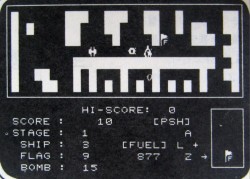
Mokpyo-neun Jeokkun-ui Gitbal
|
The first known semi-professional independent game programming team of those days was Hayaroby ("White Heron"). The studio consisted of five students (Yi Seokjun, Hyun Minho, Kim Yeonggyun, Park Saehie and Yeo Seunghun) and used to do contract works for computer stores. Hayarobi developed more than 10 titles for the Z80-based Samsung SPC-1000, two of which are known today: The shooter U.F.O Attack (by Hyun Minho) and the more elaborate Rally-X clone Mokpyo-neun Jeokkun-ui Gitbal ("Target: The Enemy Flag"; by Park Saehie). However, like their solo colleagues, the team viewed games merely as their stepping stone, and aspired to more "serious" work. An English word processor was definitely finished, and a Hangeul equivalent announced, but there's no record whether or not they ever finished the latter one26. Neither of the five has been associated with games anymore in later days, and it is told at least one member of the group has been accused of stealing a foreign game code to enter a competition.
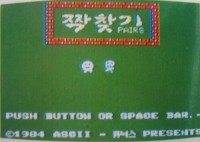
ASCII's pairs for MSX, sold by Qnix as Jjak-Chatgi
|
The only name of these times that should stay loyal to computer games and reappear in 1992 with the PC game developing house Makkoya was Hong Donghee, who in 1984 programmed games like the Sega-inspired Monaco GP as Cosmo Computer Korea27.
Things changed when computer models became more standardized during that same year, with almost all new models based on either MSX or Apple II standard. This made it possible to simply import—and then copy, as Korea still didn't protect computer programs through copyright law—foreign games, and effectively ended this generation zero of Korean game development. The technologically much inferior games just didn't stand a chance in the market, anymore. A market that was still microscopic anyway, mind you. Finding even a single individual in Korea that remembers that period or any of the games developed then wouldn't be an easy task at all. Only Samsung continued to actively support the most successful of the non-standard home computers through second parties like Static Soft and Sammi Computer, which supplied the SPC-1000 with ports of PC-6001 and MSX games until 1987, when it was ultimately pushed off the market.
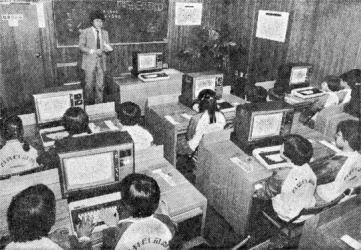
Another computer study room in 1983
|
|
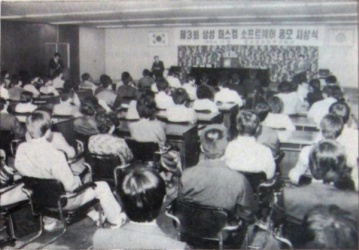
3rd Samsung Software Competition prize ceremony
|
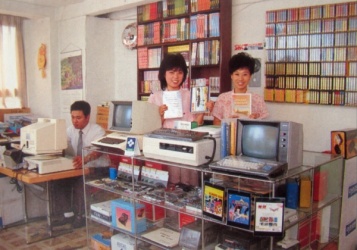
Aproman's Jonggak branch in 1986
|
|
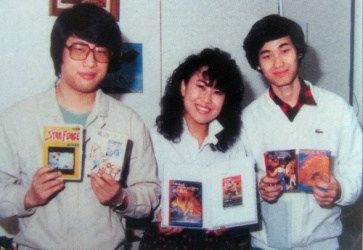
The Sammi Computer team presents their wares
|
Early commercialization of Korean-developed games: The Apple-MSX years
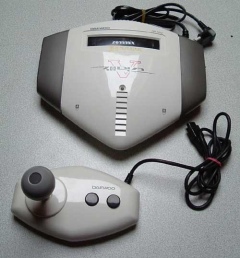
The Zemmix V, here in white, was the second and most common version.
|
Daewoo's console business only really took off in december 1985, when the Zemmix was released. Basically a consolized, cartridge based MSX computer, the machine was compatible to all MSX1 cartridges. Thanks to its reasonable price and the huge amount of imported and pirated games available for the system, it became the first successful gaming hardware and kicked off a whole industry of bootlegging. Computer store chains like Zemina, Prosoft, Clover, Topia, Screen Software and Aproman started to advertise "their" games, pirate copies of Japanese games with their "copyright" hacked in, so many gamers would think they were actually developed by those companies. Some also produced a wide range of peripherals, like light guns, music cards, and even adapters for Famicom games. In the beginning, the Zemmix' success failed to fuel any domestic game developments, though. It was simply not necessary from a market perspective, with the wide variety of Japanese and other foreign games freely available for illegitimate distribution.
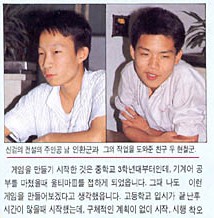
Early interview with Nam In-Hwan (left) in Computer Hakseup 10/87
|
At least not until July 1st, 1987. It was then when a law protecting copyright ownership of computer programs was enacted for the first time28. This left at least the more reputable store chains without any new games to distribute, and led to first efforts of smaller businesses to produce and publish games in a somewhat professional manner. Like many years before in the west, the actual development started in the homes and schools of nerds, though. Much like Richard Garriot in the US in 1979, Nam In-Hwan programmed his first game during his high school days on the Apple II. Sin'geom-ui Jeonseol (Legend of the Holy Sword, later officially rendered just Legend of the Sword in English) was no industry revolutionizing innovation though, but rather more than just a little bit inspired by Garriot's Ultima. Released through the hard- and software distributor Aproman, it was nonetheless hailed as the first fully-fledged Korean computer game ever, and Nam In-Hwan became known in later days as the pioneer who started Korean game development actual. Gamers were amazed to be able to play an RPG in their own language and script for the first time, even the name input was realized in Hangeul. According to a contemporary interview, Nam was already working on a second chapter at the time of its release29. That was never finished though, and a sequel shouldn't come about until 8 years later.
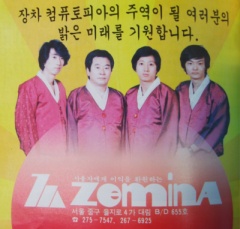
The Zemina team in a New Year's advertisement
|
Of course even under the premise of language as the main criterion, Sin'geom-ui jeonseol's pioneer status isn't entirely undisputable. There have been a few games that displayed some Hangeul text on screen before in 1984, even though the amount of text was unpreceded. As for being the first game with a proper commercial release, SunA marketed their first in-house developed arcade machine Goindol in 1987 as well, and even exported it to North America. Development for the Zemmix also got off the ground during the same year, too. Release date information for all those games is a bit murky, but SunA seem to have been the first to register their copyright for Goindol, as early as September 198730. Zemina's Brother Adventure soon followed, while Shin'geom-ui Jeonseol still wasn't listed by the end of November31.
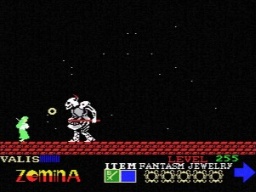
Telenet's Valis with the Zemina logo hacked in
|
The big thing for that platform became unofficial versions of popular games mostly from the arcade or the Famicom. Many of the stores that formerly used to pirate foreign games now started to port them, for the most part games that weren't available for MSX to begin with. Prosoft and Clover were particularly active, but the most representative Zemmix game publisher of that time was Zemina32. Game development still wasn't actually their main business, though. A lot of their money was made through the selling of peripherals like joypads and a Famicom2MSX converter33, and until 1987 of course not least through bootleg distribution of Japanese MSX games. Now Zemina put together their own development team and as the first company released an in-house Zemmix title, the Mario Bros. clone Brother Adventure. Later developments brought Super Mario Bros., Bubble Bobble and even Street Fighter to the Korean console. Daewoo themselves and some few third parties like Daou Infosys and SKC published a few official releases, but more games were available through the questionable channel of those copycat companies.
Kim Eulsuk, the head of Zemina's development section, said during an interview in the August 1990 issue of the computer magazine MyCom: "The most important aspect during game development and at the same time the aspect causing the most of a headache is the idea. I tend to get ideas from other games, and in a team of two the development takes about 3 months, with costs amounting to about three to four million Won (between US$4,000 and 5,600 at the time)."34
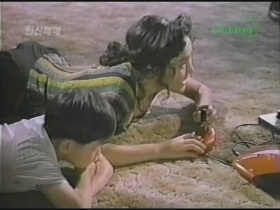
Mother and son playing Zemmix in the film Insin Maemae ("Human Trafficking")
|
From that statement and his products it becomes clear that he may have been a decent programmer, but not much of a game designer, at least at that time. This kind of plagiarism wasn't unique to the region, of course. China/Taiwan, where South Korea got most of its Famiclones from, and South America don't even have to be mentioned here, but one just has to think about The Great Giana Sisters, one of Germany's most famous early home computer games and a rather blatant clone of Super Mario Brothers. However, while the C64 game enriches it's foundation with unique ideas and - maybe even more importantly - with original art and music, Zemina's Super Boy has to be viewed as no more than a demake of the same source.
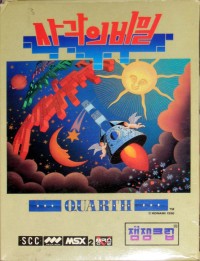
Quarth, one of the legally published games by Daou.
|
So how come there was no legal persecution of this rampant plagiarism? Well first, the law was initially rather blurry and didn't cover those ports of foreign games, as it protected only the code itself and not the IP. Korea's relatively seclusive market at the time also led to little concern about the interests of foreign copyright holders who didn't have much means to defend their rights themselves, so through more shady sources the stream of pirate copies continued to flow. This is especially true in the case of Japanese products, as anti-Japanism was still ubiquitous and many people felt they had the right to retaliation for the severe exploitation their own country suffered through Japanese colonial rule in the first half of the 20th century35.
Still, on November 12th, 1991 a group of Japanese companies around Nintendo (including Taito, Konami and Capcom) actually brought to court a case against Haitai and Young Toys, who had provided their famiclones with copied software from the industry giants. However, Young Toys were able to defend themselves thanks to the fact that all the games they used were released before July 1987, and as such the Korean copyright law didn't apply to them at that time36 (Young Toys exists to this day. Haitai was one of Korea's jaebeol then, but only the foodstuffs branch remains nowadays).
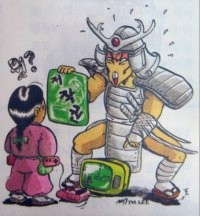
The Japanese samurai forces the copyright law on a Korean peasant. Contemporary caricature in MyCom.
|
The incident led to a single crackdown on pirate copies of newer titles the same year, but without any lasting consequences. Most interestingly Hyundai Electronics, the Korean distributor of Nintendo hard- and software, didn't show any interest in the matter whatsoever. Their official statement: "We don't see any profit in the crackdown on pirate copies at all. The pirate market is rather beneficial to our products' sales as well."37
A few years later, in 1993, game and console publishers first started marketing campaigns to fight piracy (there have been staged actual "pirate copy burnings", if only for publicity effect)38, and the same Hyundai that didn't care in 1991 went so far as to claim that Famicom clones caused eye damage39. Consistent persecution really only came into existence with the WTO in 1995, though, and there is still a lot of leeway until today, as the bootlegged games that fill every game store in Seoul attest. The more prestigeous Famiclones even used to be advertised with TV commercials, magazine ads were commonplace40.
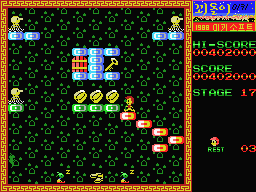
Kkoedori (MSX)
|
That isn't to say there weren't any original games at all, though. Many software houses saw in the 1987 copyright law the opportunity to establish a proper domestic game development industry, which consisted of almost completely of pirate copies and conversions of foreign games until then41. In their later years, even Zemina put out a few less plagiarizing games, like the last two Super Boy episodes, still with stolen graphics from Super Mario World, but with unique levels and gameplay elements, and the vertical scrolling shmup Cyborg Z. Most of the creative energy lay with smaller independent teams, though, most of which would produce only one or two games and then disappear again. Kim Gwanglae and Jang Changsoo of Mickey Soft brought Kkoedori (translates to something like "Little Sunshine") in 1988, a puzzle platformer similar to Solomon's Key, but self-contained enough with interesting gameplay variations on the concept. The game music by Jung Kyungtaek was less inventive, though. It consists of imitations of the Korean title songs to the then popular Galaxy Express 999 and Magical Princess Minky Momo. Mickey Soft was never heard of since (at least not as a game producer), neither were the two main developers. A better fate met the members of New Age Team, lead by Lee Sanghun, Lee Kyuhwan and Lee Sangyoun, the latter two of which should later rise to fame with Phantagram and the Kingdom under Fire series. Their first MSX title was the single screen action platformer Legendly Night (1988) for Topia, afterwards they've been freelancing by Zemina to program the ultra hard shmup The Three Dragons Story and an MSX port to Double Dragon.
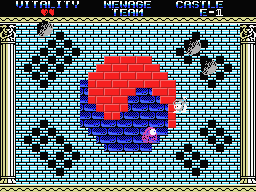
Legendly Knight (MSX) showing some patriotism
|
Topia continued to produce some more games without the future stars, focusing on action-RPGs for various platforms. Aproman also remained a very active supporter of the domestic industry during the eighties, with at least seven original titles for Apple II and MSX in all. Together with SKC Softland, they also issued a sponsorship for aspiring developers in 1988, which included a publishing deal for the winning game Miss Apple, an arcade style labyrinth game. None of these early home computer developers quite managed the jump to 16 bit, though, and they soon dropped out of the game business. Only Zemina continued to produce Zemmix games until 1992.
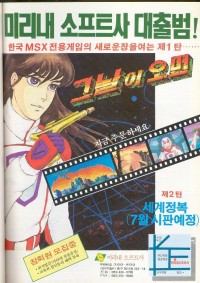
Ad for the unreleased MSX game Geu Nal-i Omyen 1
|
The Zemmix was updated with several revisions and alternate color schemes through the years and dominated the home entertainment games market for the rest of the 80's. The Zemmix Super V, released in 1990, even complied with the MSX2 standard and allowed to connect a keyboard and a floppy drive. When the MSX2+ based Zemmix Turbo was released, though, the days of the platform were already over, resulting in its incredible rarity42. Developers, however, stayed focused on the MSX1, with very few (actually, two) exceptions.
The most ambitious and best remembered MSX title was Mirinae Software's The Day 2 (Geu Nal-i Omyeon 2 in Korean). It arrived in 1990 for the MSX2 on three floppy disks, hence it was incompatible with most Zemmix consoles (the exception being the Zemmix Super V when upgraded with a floppy disk drive). While some other games made decent use of the standard Zemmix' (ergo MSX1) capabilities, The Day 2 was a fulminant sidescrolling shooter that didn't need to hide from the likes of Gradius or Aleste for the system. Why only part two? The MSX version of the first game went so far that it has been advertised in Korean magazines, but was deemed not able to compete with Japanese games, by the team, and in consequence Mirinae completely scrapped the game instead of improving it like they did with the sequel for some obscure reason, keeping the confusing numeration for their second attempt. Mirinae's old website in 1997 also listed a board game (probably meaning PCB) by the same title, which is said to have been shipped to Japan43. It seems the company entertained ambitions to release The Day 2 overseas as well, as all the in-game text is kept in (bad) English. Being the only developer of that time that stayed in business for most of the '90s, Mirinae went on to produce three more entries in the series, amongst a lot of other games.
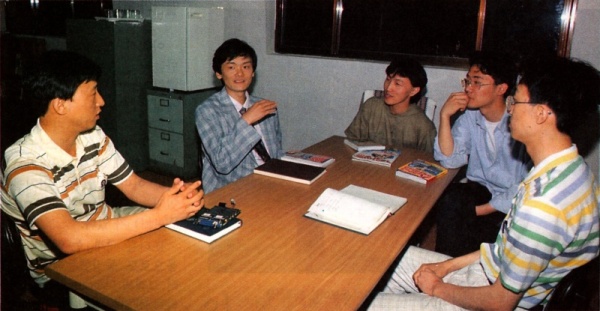
Korean designer legends at the early days of Open. Left to right: Kim Eulsuk, Koo Eunjoong, Lee Kyuhwan, Lee Sanghun, Lee Sangyoun (photo: Park Junbo of GameWorld)
|
New competition - Samsung Gam*Boy and Hyundai Comboy
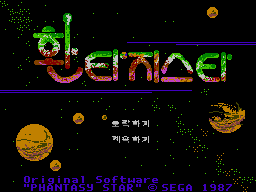
Phantasy Star in Korean
|
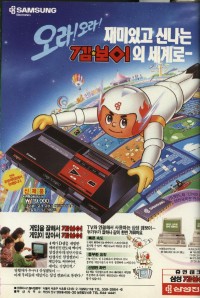
Samsung Gam*Boy magazine advertisement
|
Of course the field wasn't left to the MSX/Zemmix alone forever, but since it was difficult for foreign enterprises like Sega and Nintendo to enter the market by themselves44, they licensed their consoles out to Korean companies (check here for a list of licensed consoles in Korea). Samsung took care of Sega's Master System, which was released in April 1989 as the Samsung Gam*Boy45. They initially put a lot of effort into the venture, and where the first to really localize video games. Most releases in the 8- and 16-bit days were just thrown onto the market in their original language. Phantasy Star 1 was the first completely translated Japanese RPG in Korea, but also some less text-heavy games were localized. Kenseiden was even renamed to Hwarang-ui Geom (Sword of the Hwarang), after an antique Korean knight order, to conceal the fact that the hero was supposed to be a samurai. The Japanese knights used to be not very popular in Korea ever since a series of invasions between 1592 and 1598, and especially after the occupation during the first half of the 20th century.
The Mega Drive officially arrived in Korea already the next year, first as the Super Gam*Boy, but later all Samsung consoles had their names changed from Gam*Boy to Aladdin Boy in late 199246. Samsung also dared to produce a single game by themselves: Uju Geobukseon (Space Turtleship) was a solid but technically unimpressive vertical shoot 'em up, released in 1993. More games were announced, but Uju Geobukseon remained the only one that saw a release.
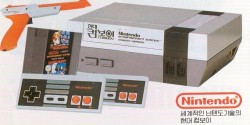
The Hyundai Comboy
|
The NES was even a bit later to the party, it didn't arrive until very late in 198947. Compared to Samsung's active support, Hyunday delivered kind of a half-assed release, though, and officially translated games were nowhere to be seen. Other than the Samsung consoles, the Hyundai Comboy still carried the original Nintendo logo, but it was accompanied by the new name in Hangeul. The console was based on the American NES rather than the Famicom, maybe to distance itself from the mass of illegal Famiclones that had been circulating for a long time by then. However, that was at the same time one factor that doomed it to insignificance, as the Famiclones were cheaper and much more games available for them. Even the few unlicensed games developed in the country were Famicom-based. The PC Engine was also available, first distributed by Daewoo as the Zemmix PC Shuttle, later (in 1993) as the Haitai Vistar (which used the pinout of the North American TG16 for the cards, but used a completely redesigned shell), but it turned up just as marginal as everywhere else in the world outside of Japan.
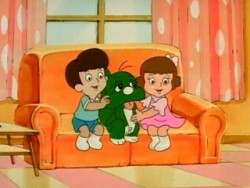
A Still from the 1987 Dooly animated series
|
Game development on the new platforms was starting slow. After all, the software necessary to program for a consolized home computer was much more readily available than for the "real" consoles, whose manufacturers limited distribution of development kits to official licensees. Most pirate companies soon found ways to simply convert their MSX games to the Master System / Gam*Boy, because of their similar hardware architecture, and sold them again for another quick buck. In very few cases this resulted in later Gam*Boy-exclusive titles, like Zemina's Super Boy 4 and Magic Kid Googoo.
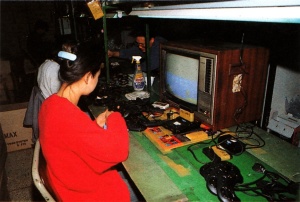
Quality assurance: The production line for Golden Bell's famicom clone console Joymax
|
The two major companies that provided for a steady flow of domestically developed games for the two consoles were Daou Infosys and an affiliated development house called Open Production, founded by Kim Eul Suk and consisting of several former Zemina employees and freelancers. Together they published games for both of the consoles under the label Jaem Jaem Club (Fun Fun Club), which Daou had already used for their official releases of Japanese MSX games. Daou's internal team was concentrated on licensed games, their debut was based on the 1987 animated TV series Agi Gongnyong Dooly (Baby Dinosaur Dooly), which itself was an adaption of the comic series of the same title about a small dinosaur who lives to see the modern times after being frozen in an iceblock for millions of years. It has also been reimagined lately with a new TV show. Agi Gongnyong Dooly the game was still first released on the MSX, but all of Daou's subsequent games have been Famicom- or Master System exclusives. Their other prestigeous license was Janggun-ui Adeul (The General's Son), originally a three part gangster epos by director Im Kwon Taek, which spawned a fighting game on the Famicom and a brawler on the Gam*Boy, both going by the same title.
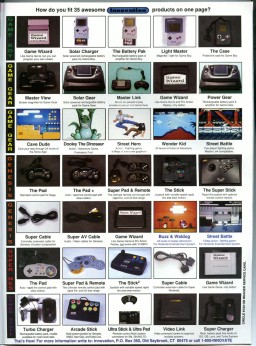
Ad by Innovation featuring various Daou / Open titles
|
Open on the other hand was responsible for original IPs. Their first games appeared in late 1992 independently, but they became a second party to Daou in 199348. Most of their games were platformers more or less similar to other famous series, but much more inventive compared to the products of the Zemina years. All feature original sprites, levels and gameplay, but for some reason minor background elements in some releases are still stolen from various Super Mario titles, spoiling the otherwise flawless impression a bit. When Daou backed out of the game production in 1994, Open continued to develope a few PC games for a handful of projects. A few Open games apparently were also produced in cooperation with the distributor SIECO and a store called Game Line.
Two games by this company duo even got picked up by the American publisher Innovation Technology and have almost been made available in the US as inofficial carts, but in the end, neither of those got released. For the Master System (or would-be Game Gear in North America) version of The Dinosaur Dooley, Daou requested a tape of typical Western music from Innovation, purportedly to get a feeling for what kind of music Americans liked49. What they ended up with was a localization of the game full of cover versions of popular songs. It is quite obvious why this game became problematic to release. Not as clear is why Buzz & Waldog for the NES met the same fate50. Open Production's surprisingly good platformer released as Koko Adventure in Korea, could only have bothered Nintendo for a few grass sprites stolen from Super Mario Bros 2, and they wouldn't have been fond of unlicensed games to begin with.
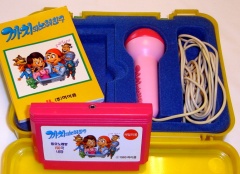
The Kkachi karaoke box
|
Eventually, some Open games made it to the west, but it was Australia where they were finally released. HES, a publisher of several items of unlicensed stuff, brought out the cartridge "4 Pak All Action" with Open's Wonder Kid, Toto World 3, Suho Jeonsa and a game still unaccounted for called Twin Mouse (the titles for all games differed from the Korean versions)51. That was in 1995, though, when the Master System was as good as dead even in Korea herself.
About a year after Open came about, the hard- and software distributor HiCom also used the two consoles for a series of games based on Kkachi, a famous manhwa and animation character by Lee Hyunse. This only resulted in a single platformer for the Aladdin Boy titled Gaegujangi Kkachi, and on the Famicom Kkachi-wa Norae Chingu (Kkachi and his Singing Friends), a karaoke set for kids.
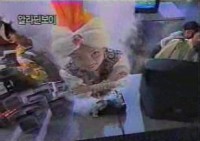
Aladdin Boy from Samsung's commercials
|
The Game Boy and other handhelds might seem to have been predestined for the contemporary Korean industry, as it would have guaranteed short and cheap development cycles, but for some reason it was almost completely neglected. The Japanese company NCS once announced a planned cooperation for Game Boy titles with a Korean company called Gametech, but it appears that those plans never came to fruit52. There have been, however, a few select instances of handheld developments for other markets outsourced to Korean programmers53.
The SNES or Super Comboy was officially available in Korea since 1992, and the Mega Drive of course long before that, but a transition to the 16-bit console generation never really happened, at least not from a developer's point of view. The reason was an alternative platform that was already beginning to shape up, more readily available, easier to program for and without even a licensing policy to violate.
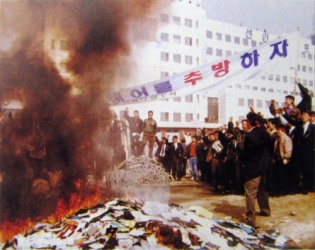
... nothing like a good (pirate) software burning
|
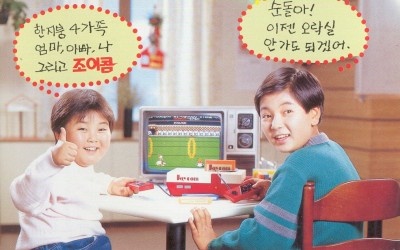
Two boys from an advertisement enjoying their pirate Famiclone
|
The rise of the IBM-PC as the major gaming platform
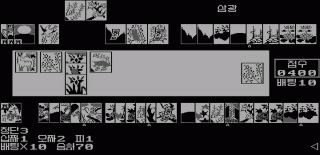
Godori by Kim Honggi, an early IBM PC game (1988)
|
Up to that point Korean developers were struggling desperately to catch up with the competition from Japan or North America. First releases like Singeom-ui Jeonseol and Brother Adventure could score some successes and even held top-10 places for several months, but after the first excitement about "our games" wore off, things got stagnant. By 1990, the industry found itself in a serious slump, while the import market flourished54. Programmers as well as designers (who were still more often than not one and the same person) were quick to admit their own technical and substantial shortcomings. Kim Eulsuk declared in 1989 "There are just not many people who would want to pay 8,000 to 15,000 Won [the general price range for games at that time] for our still rather deficient games"55, while Kkoedori's Musician Jung Kyungtaek lamented the fact that gamers' standards had been elevated by foreign software to a level domestic developers were just not able to reach56.
But lack of skill wasn't even the main problem: Budgets and manpower were even much more sparse. The largest teams used to consist of no more than four or five main staff members, and many published games were still actually homebrew developments done by students in their free time. Development cycles were limited to a few months, to make the endeavor financially worthwile to begin with.
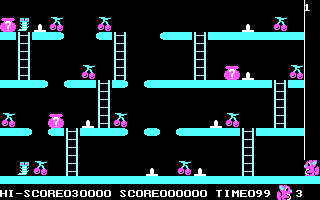
Bong Bong
|
Just like in the west, the IBM compatible PC didn't start out as a popular gaming platform. Due to the fact that few people owned one with a color graphics card, almost all programs until 1992 were displayed in monochrome only, with very few exceptions. Known homebrew CGA games are a Tetris variant called Korean Tetris, and Bong Bong. The latter was programmed by one Lee T.K, then a computer science student at Yonsei University57. Done in 1989, Bong Bong was yet another a single screen platformer based off the now seven years old arcade game Ponpoko. Pak Seonggyu, the programmer of Korean Tetris, later founded the arcade game manufacturer F2 System58. Popular EGA games of this period were Kim Sungshik's (Danbi System) unofficial port of Knightmare, completed in August 1990, and yet another Ponpoko clone.
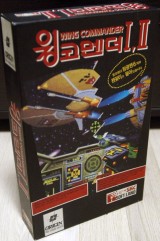
The Korean box for Wing Commander I & II
|
In this same vein, the first years on the PC were dominated by freeware developments, mostly ports or adaptions of traditional board and card games. The only known commercially published PC titles before 1992 were Aproman's unauthorized version of Konami's King's Valley, and Pungnyu Hyeopgaek, an action RPG by Topia set in ancient China.
However, everything changed when PC systems able to display colored graphics became more common. The industry made an instant jump to VGA graphics, and by 1992 produced games that could try to compete with what was available on consoles at the same time, and some of them wouldn't even have had to hide too far behind at least the average PC game on the contemporary international market. Of course, they held nothing against high budget productions by American market leaders like Origin, which had also been brought to Korea by SKC, one of the major publishers in this first half of the decade. However, the industry had developed a very flexible pricing scheme by then, and a blockbuster title like Ultima Underworld could cost twice as much as the average game59.
The first developer to wholly embrace the new market was Makkoya, Hong Donghee's then newly founded company. Makkoya's early games still weren't very impressive; they've always been most famous for a series of puzzle games called Segyun-jeon (Bacteria War), which first appeared in March 1992. It was a simple adaption of Reversi / Othello, with cutesy graphics and various starting constellations. Initially the game was ignored by the press and the users, but in time it became still very popular, and rip-offs or fan remakes appear every once in a while until today. Their other 1992 game was Yojeong Jeonsa Dwijuk (Fairy Knight Dwijuk), an exploration based sidescroller with shareware-esque flair, but in concept not unlike the more adventurous Wonder Boy sequels. Another early title was Sping, the winning entry for Hyundai's "2nd National College Student Software Contest," but it went under the radar just as much as Makkoya's first game60.
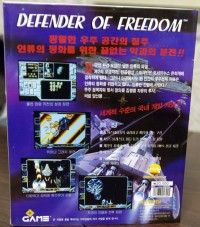
Mirinae's Defender of Freedom
|
Much more suited to advocate the newly emerging industry was Soft Action's Fox Ranger, released in May the same year through SKC. Cutscenes, screen-filling weapon effects and bosses, Sound Blaster and Roland support, voice samples and parallax scrolling in this solid horizontal scrolling shmup did almost as much for the reputation of the domestic game development as Soft Action's president Nam Sanggyu did with his energetic promotion and helped to overlook the fact that the gameplay was pretty average and uninventive. Fox Ranger became the first hit of the industry and changed the way domestic games were perceived among gamers in Korea.
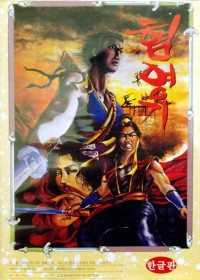
A Taiwanese game published by Jigwan
|
Before long Mirinae also returned with their first PC game, this time a vertically scrolling shooter with a small management element, released by DS Game Channel, another huge publishing house mainly focused on American games. Jayu-ui Tusa: Defender of Freedom looked and sounded noticably less impressive than Fox Ranger, but it was enough to spur a perceived rivalry between the two companies that should secure plenty of shooters for the following years. But most importantly, these Korean developers finally managed to stand their ground against the tide of technological innovation through foreign titles with these games, and began to enter an era of growth from then on.
Another turning point marked a shift in publishing affairs. While the first generation of Korean games had been built almost entirely on the back of computer store chains, now the conglomerates had become aware of the business. After SKC (whose first acts in game publishing can be traced back to 1989 with some Apple and MSX stuff) followed Goldstar (now LG), by opening the first ever educational institute for budding game developers on March 8th, 1993. In August the same year Ssangyong entered the market as well through Softnet, a jointventure with the computer import enterprise Saem Electronics. Besides their ongoing console investment, Hyundai and Samsung also made small forays to publish domestic PC games.
Korean games had still a long way in front of them, though, and soon they slowly started to lose one of their greatest advantages— the language. After Samsung's first steps in localization on the Gam*Boy, several companies picked up the same idea. SKC Softland brought Prince of Persia and Carmen Sandiego in Korean, while DS Game Channel countered more massively with Eye of the Beholder, Alone in the Dark and Legend of Kyrandia61. Translations of English games stayed the exception rather than the rule, though. After all, American companies weren't too ready to supply their source codes to a country notorious of its rampant software piracy.

The Mirinae team in 1992 (left to right: Cho Daeho, Kim Kyongsoo, Yang Jaeyoung, Jeong Jaesung)
|
But this was of no real concern from a Taiwanese point of view. With Jigwan, a company formed in late 1992 that was entirely focused on the localization of games from the island. Their mighty partner was the Taiwanese software giant Softworld, who stood on the forefront of an already well-established PC RPG industry, while Korean developers only started to stumble into the genre in 1993 with Hong Gildong-jeon, a rather coarse approach to a Japanese style RPG, but based on a traditional Korean tale.
Both vanguards of the new generation returned for a second round in 1993 with sequels to their debuts. Mirinae's Geu Nal-i Omyeon 3: Dragon Force became an instant hit, holding its position in popularity and sales charts for most of the year and sold 25,000 copies62. This might not sound like much, but for a Korean game at the time, it meant a huge success. Fox Ranger 2 on the other hand ended in a debacle. After many delays the game shipped in a bug-infested state, and publisher Goldstar was buried in complaints, so that they not only started a massive recall action, but also gave out a 50,000-Won graphics software to every buyer of the game with the patched version, which itself only cost 33,000 Won63. On top of that, Fox Ranger 2's troubled development also entailed a scandal that not only left a big stain on Soft Action's image, but also became a signifier for the industry's contemporary state as well as a signpost for the way it had yet to go in the years to come.
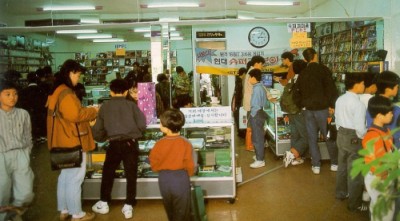
A game store in the early nineties
|
|
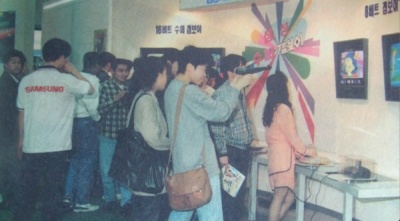
KIECO '92
|
|